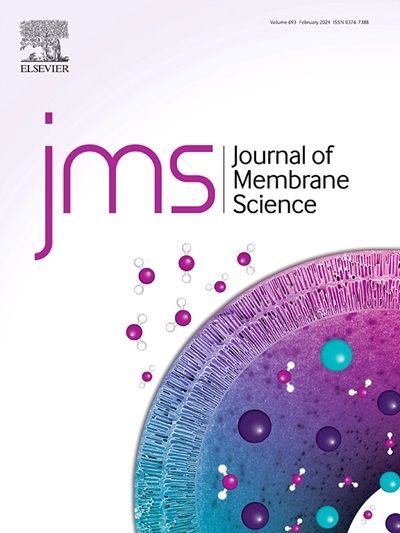Co-assembly of perfluorinated sulfonic-acid ionomer and tetraphenylporphyrin tetrasulfonic-acid contributes to high-performance proton-exchange membranes
IF 8.4
1区 工程技术
Q1 ENGINEERING, CHEMICAL
引用次数: 0
Abstract
To meet improved requirements for proton-exchange membranes (PEMs) applied in medium- and low-temperature fuel cells, novel PEMs with superior performance are prepared by using commercial perfluorinated sulfonic-acid ionomer (PFSA) and a dopant, tetraphenylporphyrin tetrasulfonic-acid (TPPS). Different from physically blending PFSA with another polymer or a nano-material, the membrane-forming mechanism of TPPS modified PFSA PEMs is highly dependent on the efficient interaction between PFSA and TPPS molecules. The unique three-part nested hydrophilic-hydrophobic-hydrophilic molecular structure of TPPS plays a crucial role in the co-assembly of PFSA with TPPS. The more intensive ionic cross-linking and hydrogen-bond networks are formed through hydrophilic groups in the outer and internal parts of TPPS and sulfonic-acid groups of PFSA. Meanwhile, secondary cross-linking of these hydrophilic groups is induced by rigid hydrophobic groups in the middle part of TPPS. Therefore, these molecular interactions induce the formation of more stable and stronger nano-phase separation with more uniform size. This novel nano-phase separation structure endows PEMs with elevated applicable temperatures, much increased proton conductivity and thus superior fuel cell performances, which are the keys to the development of more advanced hydrogen fuel cells.

求助全文
约1分钟内获得全文
求助全文
来源期刊

Journal of Membrane Science
工程技术-高分子科学
CiteScore
17.10
自引率
17.90%
发文量
1031
审稿时长
2.5 months
期刊介绍:
The Journal of Membrane Science is a publication that focuses on membrane systems and is aimed at academic and industrial chemists, chemical engineers, materials scientists, and membranologists. It publishes original research and reviews on various aspects of membrane transport, membrane formation/structure, fouling, module/process design, and processes/applications. The journal primarily focuses on the structure, function, and performance of non-biological membranes but also includes papers that relate to biological membranes. The Journal of Membrane Science publishes Full Text Papers, State-of-the-Art Reviews, Letters to the Editor, and Perspectives.
 求助内容:
求助内容: 应助结果提醒方式:
应助结果提醒方式:


